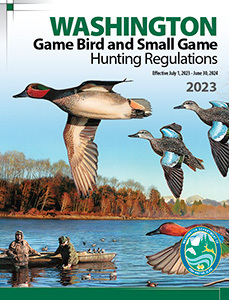Falconry
If a raptor captures any species of wildlife (quarry) in a closed season, the falconer must release the quarry if it is not seriously injured. If the quarry is seriously injured or killed, the quarry must be left at the site, but the raptor may feed on the kill.
If the accidentally killed wildlife is a Washington State Candidate species (including jackrabbit), the falconer must immediately record on a WDFW form or facsimile: the falconer’s name, falconry permit number, date, species and sex (if known) of the quarry, and the location of the kill (as accurately as possible).
Total accidental take of Candidate species cannot exceed 5/season; falconers must cease hunting for the day if a candidate species is taken.
A list of candidate species can be found at: wdfw.wa.gov/species-habitats/at-risk/listed
All reports of accidental take must be submitted to the WDFW falconry permit coordinator by April 1 each year.
Released quarry are not considered “take.” Federal and state laws to not permit the take of endangered, threatened, sensitive or other protected species.
For more information on Falconry, visit https://wdfw.wa.gov/hunting/requirements/falconry/overview
2023-2024 Falconry Seasons |
||||
Species |
Area |
Season Dates (inclusive) |
Daily Bag Limit |
Possession Limit |
Turkey |
Eastern Washington |
Sept. 1 - Feb. 15 (falconry) |
1 turkey, either sex, per turkey tag with a maximum of 2 turkeys per season |
2 (tag required for each turkey) |
Upland Game Birds & Forest Grouse |
Statewide |
Aug. 1 - Mar. 15 (falconry) |
2 pheasants (either sex), 6 partridge, |
Twice the daily bag |
Cottontail and |
Statewide |
Aug. 1 - Mar. 15 (falconry) |
5 cottontail or snowshoe hares, straight or mixed bag |
15 mixed bag |
Jackrabbit, pygmy rabbit, sage grouse, sharp-tailed grouse, ptarmigan - Closed statewide |
||||
Mourning Dove |
Statewide |
Sept. 1 - Dec. 16 (falconry) |
3 mourning doves, straight or mixed bag with snipe, coots, ducks, and geese during established seasons |
Three times the daily bag |
Ducks, Coots, Snipe and Geese (except Brant) |
Statewide |
Same season dates for each species in each area listed previously (falconry) |
3, straight or mixed bag including duck, coots, snipe, geese and mourning doves during established seasons |
Three times the daily bag |
Ducks, Coots & Geese (extended falconry) |
Western Washington |
Sept. 23 |
3, straight or mixed bag including duck, coots, Canada and White-fronted Geese |
Same as the daily bag |
Eastern Washington |
Sept. 30 |
3, straight or mixed bag including duck, coots, Canada and White-fronted Geese |
Same as the daily bag |
|
Statewide |
Feb. 3 |
3, straight or mixed bag including duck, coots and all geese |
Same as the daily bag |
|

